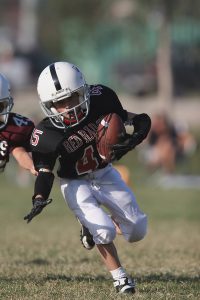Latest Issue of Concussion Defense Reporter Highlights Industry Trends and Most Recent Litigation
(Editor’s Note: What follows is the letter from the editor of Concussion Defense Reporter, Tony Corleto of Wilson Elser. To subscribe to CDR, which is complimentary, visit https://www.concussiondefensereporter.com/)
The Surgeon General has not determined … .
A recent publicity campaign features the image of a mother helping  her 10-year-old son, in football gear, light a cigarette. The media reel for that campaign shows a coach, post-game, handing out cigarettes to youth football players. An adolescent male voice begins “Tackle football is like smoking “ and concludes “Choose flag under 14”. In a vacuum, one might presume the Surgeon General has issued a public health warning. Wrong. It’s just the Concussion Legacy Foundation (CLF) on its latest cycle.
her 10-year-old son, in football gear, light a cigarette. The media reel for that campaign shows a coach, post-game, handing out cigarettes to youth football players. An adolescent male voice begins “Tackle football is like smoking “ and concludes “Choose flag under 14”. In a vacuum, one might presume the Surgeon General has issued a public health warning. Wrong. It’s just the Concussion Legacy Foundation (CLF) on its latest cycle.
On November 11, JAMA Pediatrics published the results of a two year review by a consensus panel of 11 pediatric experts in various fields (neurology, psychology, physical medicine and rehabilitation, sports and exercise, athletic training, epidemiology, prevention), to summarize current literature (1980 – 2018) and provide recommendations regarding the prevention, assessment and management of Sports Related Concussion in youth athletes. The conclusion: “There is not a recommended age or developmental stage at which contact and collision are most safely introduced for practice or competition”. The only age specific recommendation was in ice hockey, to delay body checking until 13.
CLF has taken the campaign against youth football to state legislatures, most recently in Massachusetts and New York. Previous efforts in Illinois and California failed, we expect the latest efforts to face the same fate. In this edition of Concussion Defense Reporter, we provide information about the proposed MA bill, including testimony from Scott Hallenbeck (USA Football), Dr. Julian Bailes and Jon Butler (Pop Warner).
Even though media remains ahead of the science, the law seems to get it. Two recent decisions denied class certification for concussion claims. In Jones v BRG (1:18-cv-07250, USDC, ND ILL, 8/1/19), district Court granted Riddell’s motion to strike class a proposed class of “All individuals who wore a Riddell helmet while participating in a High School and/or College Level football program between 1975 and the present”. Recognizing that the claims essentially sought recovery for personal injury, the court acknowledged that individual inquiries particular to each claimant’s activity, exposure and injury would predominate over any common claims about the products at issue, making individual litigation superior to class treatment. Similarly, in Archie v Pop Warner (2:16-cv-06603, USDC, CD CA, 9/1//19) district court found that a proposed class of “All persons who enrolled their minor children in Pop Warner tackle football from 1997 to present”, for statutory false advertising claims, failed to satisfy the predominance requirement of Rule 23(b)(3). As in Jones, the decision turned on a finding that specific individualized inquiry would be needed for each claimant in the proposed class to determine whether they had in fact been exposed to and relied on the alleged advertisement. This edition of Concussion Defense Reporter includes a detailed analysis of the Archie decision.
Cheerleading is again in the spotlight. We report two decisions, one in favor of a school district and one for a university. In a “second hit” case, Stevens v Azusa Pacific Univ. (2019 WL 2281585, Ca Ct, App., 5/29/19), the appeals court affirmed a ruling that the cheerleader assumed the risk of injury and that a qualified but uncertified coach did not “increase the risk” of harm. In Biancorosso v Troy Comm. Cons. SD (App. Ct. Ill no. 2-18-0613 8/29/19) the appeals court upheld summary judgment for the school district, over a flier’s claim that the district was negligent or reckless because a cheer mat did not prevent her concussion when she fell out of a stunt.
Last but not least: One NCAA MDL plaintiff has dropped his case because he feels benefit from infrared light therapy Carr v NCAA, Brigham Young (1:16-cv-08581, USDC ND IL) and the Minnesota Vikings overturn an adverse worker’s compensation award Noga v Minnesota Vikings Football Club, 2019 WL 3439661, S. Ct, 2019.
